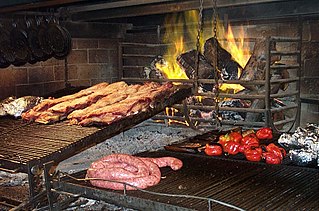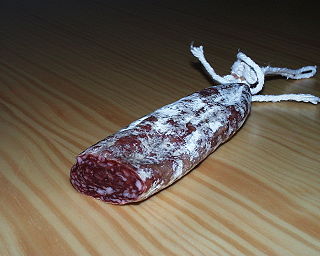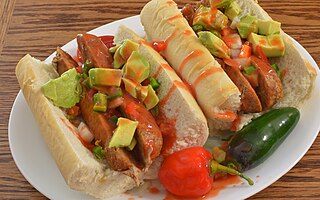
Cajun cuisine is a style of cooking developed by the Cajun–Acadians who were deported from Acadia to Louisiana during the 18th century and who incorporated West African, French and Spanish cooking techniques into their original cuisine.

A sausage is a type of meat product usually made from ground meat—often pork, beef, or poultry—along with salt, spices and other flavourings. Other ingredients, such as grains or breadcrumbs may be included as fillers or extenders.

Botifarra is a type of sausage and one of the most important dishes of the Catalan cuisine.

Hungarian or Magyar cuisine is the cuisine characteristic of the nation of Hungary, and its primary ethnic group, the Magyars. Hungarian cuisine has been described as being the spiciest cuisine in Europe. This can largely be attributed to the use of their piquant native spice, Hungarian paprika, in many of their dishes. A mild version of the spice, Hungarian sweet paprika, is commonly used as an alternative. Traditional Hungarian dishes are primarily based on meats, seasonal vegetables, fruits, bread, and dairy products.

Salami is a cured sausage consisting of fermented and air-dried meat, typically pork. Historically, salami was popular among Southern, Eastern, and Central European peasants because it can be stored at room temperature for up to 45 days once cut, supplementing a potentially meager or inconsistent supply of fresh meat. Countries and regions across Europe make their own traditional varieties of salami.

Chorizo is a type of pork sausage originating from the Iberian Peninsula. It is made in many national and regional varieties in several countries on different continents. Some of these varieties are quite different from each other, occasionally leading to confusion or disagreements over the names and identities of the products in question.

Fuet is a Catalan thin, dry-cured, sausage of pork meat in a pork gut, covered with white, edible mold—similar to salami. The most famous is made in the comarca (county) of Osona and is also known as Vic fuet. Other places that have long tradition of making it are the city of Olot and the surrounding areas.

Asado is the technique and the social event of having or attending a barbecue in various South American countries, especially Argentina, Chile, Paraguay and Uruguay where it is also a traditional event. An asado usually consists of beef, pork, chicken, chorizo, and morcilla, all of which are cooked using an open fire or a grill, called a parrilla. Usually, red wine and side dishes such as salads accompany the main meats, which are prepared by a designated cook called the asador or parrillero.

Adobo or adobar is the immersion of cooked food in a stock composed variously of paprika, oregano, salt, garlic, and vinegar to preserve and enhance its flavor. The Portuguese variant is known as carne de vinha d'alhos. The practice, native to Iberia, was widely adopted in Latin America, as well as Spanish and Portuguese colonies in Africa and Asia.

Chistorra is a type of fast-cure sausage from Aragon, the Basque Country and Navarre, Spain. It can be considered a special type of chorizo. It is made of minced pork, or a mixture of minced pork and beef, is encased in either lamb tripe or plastic and has a fat content that varies between 70 and 80%. The sausage is flavoured with garlic, salt and paprika, which gives it a bright-red colour. It is usually baked, fried or grilled and often accompanies other dishes, sometimes as part of tapas. The final cured product tends to be thinner than traditional chorizo or sausage, with a diameter of approximately 25 mm. The sausages average 40 cm (16 in) in length, though there are cases when they reach up to 1 m long.

Vienna sausage is a thin parboiled sausage traditionally made of pork and beef in a casing of sheep's intestine, then given a low-temperature smoking. The word Wiener is German for 'Viennese'. In Austria, the term "Wiener" is uncommon for this food item, which instead is usually called Frankfurter Würstl.
Embutido, enchido or embotit (Catalan) is a generic term for cured meat products. The dictionary of the Royal Spanish Academy defines it as "intestine stuffed with minced meat, mainly pork; intestine stuffed with diverse ingredients". The term often applies to any of the many varieties of cured, dry sausages found in the cuisines of Iberia and the former Spanish and Portuguese colonies.
The Pamplona is a grilled stuffed-meat dish from Uruguay prepared with chicken, and may be prepared with other meats such as pork and beef. It has also become increasingly popular in Argentina.

Longaniza is a Spanish sausage (embutido) similar to a chorizo and also closely associated with the Portuguese linguiça. Its defining characteristics are interpreted differently from region to region. It is popular in the cuisines of several regions of Spain, Argentina, Uruguay, Puerto Rico, Dominican Republic, El Salvador, Guatemala, Mexico and Chile. In the Philippines, it is called longganisa and has hundreds of variants with different vernacular tastes and forms due to the 144 ethno-linguistic groups of the archipelago.

Hungarian sausages are sausages found in the cuisine of Hungary. Hungary produces a vast number of sui sausage types. They may be boiled, fresh or dried, and smoked, with different spices and flavors, "hot" or "mild". Many were influenced by their neighbors and brethren.

Salchichón is a Spanish summer sausage that is made by smoking, drying, cooking or some combination. It is made with pork, although some recipes use other meats including ox, veal or horse.

A hot link is a type of sausage used in the cuisine of the Southern United States, and a part of American barbecue, soul food, and Cajun and Louisiana Creole cuisines. It is also a part of Texan cuisine and the cuisine of Chicago, Illinois. The hot link is usually prepared using pork, beef, or a combination of both. It is sometimes used as an ingredient in other dishes, such as jambalaya and gumbo. Hot link sausages are mass-produced by some companies in the United States.
















